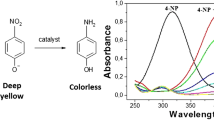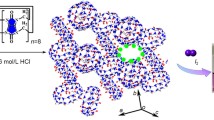Abstract
The sorption of anisole and some related aromatic ethers on the interlamellar surfaces of Cu(II) hectorite has been investigated by i.r. and e.s.r. spectroscopy. In addition to physical adsorption, anisole forms two distinct types of Cu(II) complexes which are analogous to the type I and II species previously reported for benzene-Cu(II) smectite systems. These complexes can be transformed to type I and II complexes of 4,4’-dimethoxybiphenyl. Possible mechanisms are proposed for the oxidation process. Butyl phenyl ether formed a type II complex with Cu(II)-hectorite, but no dimerization reaction was noted in this system. Phenyl ether and benzyl methyl ether form a type. π complex with Cu(II)-hectorite. No type II analog was noted. E.S.R. spectra of each of the type II ether-Cu(II)-hectorite systems showed a single, narrow band with g near the value expected for a “free spinning” electron. The type I phenyl ether and benzyl methyl ether complexes also exhibited this e.s.r. band. Ag(I) hectorite adsorbs anisole by forming exclusively a type I complex. Na(I) and Co(II) hectorite adsorb anisole by physical means only, indicating association with the silicate surface.
Résumé
La sorption de l’anisole et de certains éthers aromatiques voisins par les surfaces interlamellaires de l’hectorite Cu(II) a été étudiée par spectroscopie infrarouge et résonance de spin électronique. En plus de l’adsorption physique, l’anisole forme deux types distincts de complexes Cu(II) que sont analogues aux types I et II précédemment signalés dans le cas des systèmes benzène-smectite Cu(II). Ces complexes peuvent être transformés en les types I et II des complexes du 4-4’ dimethoxybiphenyl. Des mécanismes possibles sont proposés pour le processus d’oxydation. Le butyl phenyl éther forme un complexe du type II avec l’hectorite Cu(II), mais aucune réaction de dimérisa-tion n’est notée dans ce système. Le phenyl éther et le benzyl methyl éther forment un complex. v du type I avec l’hectorite Cu(II). Aucun analogue du type II n’est noté. Les spectres de RSE de chacun des systèmes éther-hectorite Cu(II) du type II montrent une bande unique et étroite avec g voisin de la valeur attendue pour un électron à “spin indifférent”. Les complexes du type I obtenus avec le phenyl éther et le benzyl methyl éther montrent également cette bande en RSE. L’hectorite Ag(I) adsorbe l’anisole en formant exclusivement un complexe du type I. Les hectorites Na(I) et Co(II) adsorbent l’anisole par voie physique seulement, ce qui indique une association avec la surface du silicate.
Kurzreferat
Die Sorption von Anisol und einigen verwandten aromatischen Äthern an den Zwischenschichtoberflächen von Cu(II)—Hectorit wurde mit Infrarot—und Elektronenspinresonanz Spektroskopie untersucht. Zusätzlich zur physikalischen Adsorption bildet Anisol zwei verschiedene Typen von Cu(II)—Komplexen, die den früher für Benzol-Cu(II)-Smectit-Systeme beschriebenen Typen I und II analog sind. Diese Komplexe können in Typ I- und II-Komplexe von 4,4’-Dimethoxydiphenyl umgewandelt werden. Mögliche Mechanismen für den Oxidationsprozeß werden vorgeschlagen. Butylphenyläther bildet einen Typ II-Komplex mit Cu(H)-Hectorit, jedoch wurde in diesem System keine Dimerisationsreaktion festgestellt. Phenyläther und Benzylmethyläther bilden mit Cu(II)-Hectorit einen Typ I-ß-komplex. Analoge Type II-Komplexe wurden nicht gefunden. ESR-Spektren von jedem der Typ II-Ather-Cu(II)-Hectorit-Systeme zeigten ein einzelnes, schmales Band mit g nahe dem Wert, der für ein Elektron mit “freiem Spin” zu erwarten ist. Phenyläther- und Benzylmethylätherkomplexe vom Typ I wiesen ebenfalls dieses e.s.r.-Band auf. Ag(I)-Hectorit adsorbiert Anisol ausschließlich durch Bildung von Typ I-Komplexen. Na(I)- und Co(II)-Hectorit sorbieren Anisol nur auf physikalischem Wege, was auf eine Bindung an die Silikatoberfläche hinweist.
Резюме
Сорбция анизола и некоторых родственных простых эфиров ароматического ряда на межпластинчатых поверхностях Си(П)-гекторита изучалось инфракрасной и электронной спиновой резонансной спектроскопией. Добавочно к физической адсорбции, анизол образует два обособленных типа комплексных соединений Cu(II), которые аналогичны группам I и II как ранее сообщалось для систем бензол-Си(И) смектитов. Эти комплексные соединения можно перегруппировать в комплексные соединения типа I и II 4,4’-диметоксидифенила. Выдвигаются возможные механизмы процесса окисления. Бутилфеноловый эфир с Cu(II)-гекторитом образует комплексное соединение типа II, но в этой системе не замечается реация димеризации. Феноловый и бензилодиметиловый эфиры с Си(П)-гекторитом образуют комп¬лексное соединение типа I п. Аналог типа II не был замечен. Спектр электронного спинового резонанса каждого типа системы эфира-Си(Н)-гекторита показал одну узкую полосу, с g приближающимся к значению ожидаемого от «свободно вращающегося относительно своей оси» электрона. Комплексные соединения фенолового и бензилодиметилового эфиров типа I также проявляют эту полосу электронного спинового резонанса. Ag(I) гекторит адсорбирует анизол образуя исключительно сложное соединение типа I. Na(I) и Со(Н) гекторит адсорбирует анизол только физическим спосбом, что указывает на ассоциацию с силикатной поверхностью.
Similar content being viewed by others
References
Clementz, D. M. and Mortland, M. M. (1972) Interlamellar metal complexes in layer silicates—III. Silver(I)-arene complexes in smectites: Clays and Clay Minerals 20, 181–186.
Clementz, D. M., Pinnavaia, T. J. and Mortland, M. M. (1973) Stereochemistry of hydrated copper(II) ions on the interlamellar surfaces of layer silicates: An e.s.r. study: J. Phys. Chem. 77, 196–200.
Doner, H. E. and Mortland, M. M. (1969) Benzene complexes with copper(II) montmorillonite: Science 166, 1406–1407.
Fenn, D. B. and Mortland, M. M. (1972) Interlamellar metal complexes in layer silicates—II. Phenol complexes in smectites. Proceedings International Clay Conference. Madrid, Spain.
Green, J. H. S. (1962) vibrational spectra of benzene derivatives—III Anisole, ethylbenzene, phenetole, methyl phenyl sulphide and ethyl phenyl sulphide. Spectrochim. Acta 18, 39–50.
Kovacic, P. and Kyriakis, A. (1963) Polymerization of benzene to p-polyphenyl by aluminum chloride-cupric chloride: J. Am. Chem. Soc. 85, 454–458.
Mortland, M. M. and Pinnavaia, T. J. (1971). Formation of copper(II) arene complexes on the interlamellar surfaces of montmorillonite: Nature (Phys. Sci.) 229, 75–77.
Mortland, M. M. and Raman, K. V. (1968) Surface acidity of smectites in relation to hydration, exchangeable cation, and structure: Clays and Clay Minerals 16, 393–398.
Pinnavaia, T. J. and Mortland, M. M. (1971) Interlamellar metal complexes on layer silicates. I—Copper(II)-arene complexes on montmorillonite: J. Phys. Chem. 75, 3957–3962.
Rupert, J. P. (1973) Electron spin resonance spectra of interlamellar Cu(II)-arene complexes on montmorillonite: J. Phys. Chem. 77, 784–790.
Stephenson, C. V., Coburn, W. C. Jr. and Wilcox, W. S. (1961) The vibrational spectra and assignments of nitrobenzene, phenyl isocyanate, phenyl isothiocyanate, thioylaniline and anisole. Spectrochim. Acta 17, 933–946.
Author information
Authors and Affiliations
Additional information
Journal Article No. 6268, Michigan Agricultural Experiment Station, Michigan State University, East Lansing, Michigan, 48823.
Rights and permissions
About this article
Cite this article
Fenn, D.B., Mortland, M.M. & Pinnavaia, T.J. The Chemisorption of Anisole on Cu(II) Hectorite. Clays Clay Miner. 21, 315–322 (1973). https://doi.org/10.1346/CCMN.1973.0210507
Received:
Published:
Issue Date:
DOI: https://doi.org/10.1346/CCMN.1973.0210507




